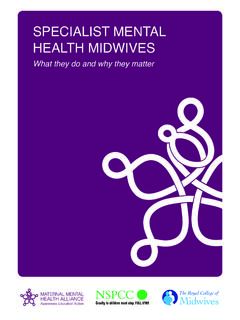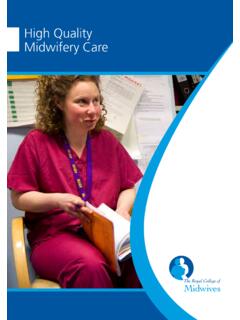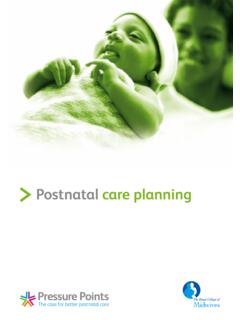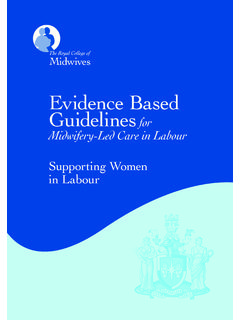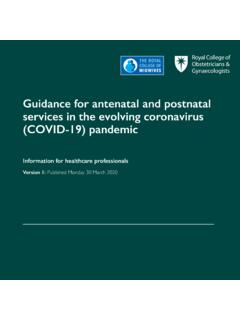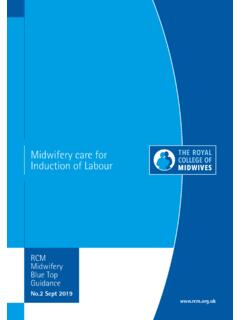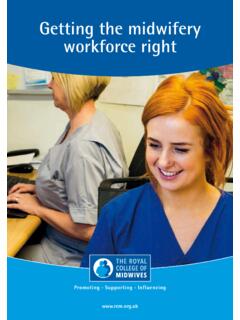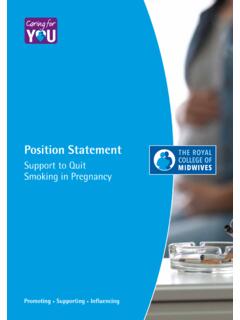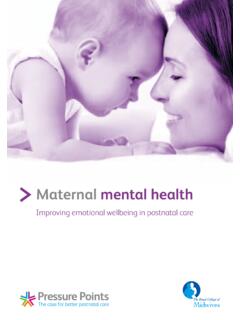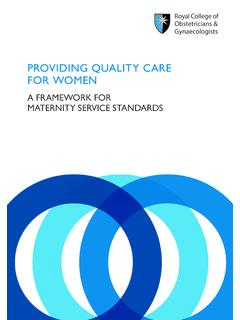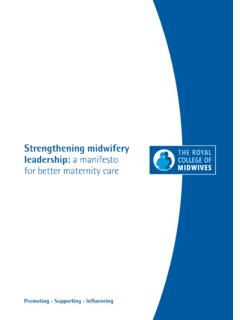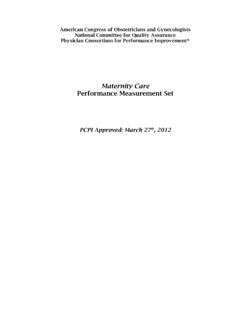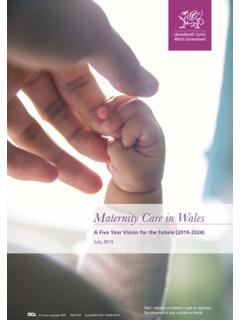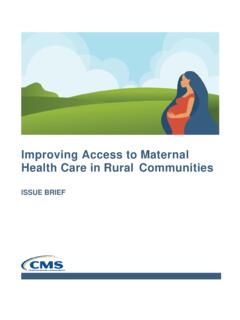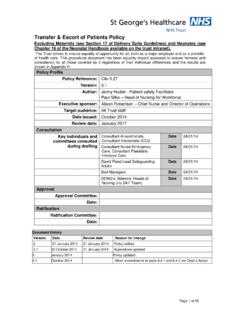Transcription of The contribution of continuity of midwifery care to high ...
1 contribution of continuity of midwifery care to high quality maternity care Professor Jane Sandall CBE2 The Royal College of MidwivesThe contribution of continuity of midwifery care to high quality maternity 3 Professor Jane Sandall CBEThe contribution of continuity of midwifery care to high quality maternity careProfessor Jane Sandall CBEW omen s access to quality midwifery services has become a part of the global effort in achieving the right of every woman to the best possible health care during pregnancy and childbirth What does high quality maternity care look like?Current national maternity policies clearly identify the centrality of the midwifery workforce s contribution to high quality and safe care . The dimensions of care quality often used in UK country policies draw upon a definition in Crossing the quality Chasm as safe , effective, patient-centred, timely, efficient, and equitable care 2. Thus high quality maternity care should: do no harm to people who use the service or those that provide it; be responsive and create no delay when complications occur; be organised to maximise efficient use of resources including the maternity care workforce; provide evidence based care ; be women and family centred which involves facilitating informed decision making, women and families feeling safe , respected, treated with dignity and having their voices listened and responded to; be organised so that services that some women find hard to reach are accessible and equitable.
2 In addition, a high quality maternity care system should provide optimal maternity care that follows the principle of effective care with least harm and supports the beneficial practices that support women s own innate capacities or the physiologic process of childbirth, whilst able to deliver timely rapid escalation and response when needed. Current Policy in the United Kingdom continuity of care has been at the heart of maternity policy in England since 1993 with the publication of Changing Childbirth 3 and an emphasis on Choice, continuity and Control, in the NSF maternity Standard 4 and maternity Matters 5. Better Births highlights the importance of continuity of carer, to ensure safe care based on a relationship of mutual trust and respect in line with the woman s decision 6. Scotland s new Best Start policy of 2017 identified continuity of carer as the cornerstone for the development of maternity services across Scotland over the next five years. Ambitions regarding continuity of midwife care are also expressed in Welsh 7 and Northern Irish Policy The Royal College of MidwivesThe contribution of continuity of midwifery care to high quality maternity 5 Professor Jane Sandall CBEthroughout pregnancy, birth and the postnatal period; providing the woman with individualised education and counselling; being cared for by a known and trusted midwife during labour and the immediate postpartum period; and identifying and referring women who require obstetric or other specialist attention and acting as an advocate and care navigator.
3 continuity of midwifery care is provided in a multi-disciplinary network of consultation and referral with other care providers. continuity of midwifery care can be provided through a team of midwives who share the caseload, often called team midwifery . Another model is caseload midwifery , which aims to ensure that the woman receives all her care from one midwife or practice partner. Midwives follow women across the care pathway and provide antenatal care in community and hospital settings, intrapartum care in the home, midwife-led units and obstetric units, and postnatal care in hospital and at home to women who are both low and high risk. This contrasts with shared- care models, where responsibility is shared between different healthcare professionals and women may not know their care providers or have met who is caring for them in labour previously is some evidence around what factors are important for continuity of midwifery models of care to be sustainable and avoid burnout.
4 Low job control and long working hours are associated with higher levels of burnout in midwives 15. Ways of working that engender greater job control, meaningful relationships with women 16 and collegial support help midwives maintain work/life balance 17 18. Although there is greater agency for midwives in midwife-led models of care and settings, there can be a problematic interface with host units, and a clash of culture 19. Key areas affecting midwifery morale identified, in particular have been staffing levels, flexible working and work life balance, working relationships and organisational issues 20 Why is continuity important to providers and users of health services? continuity of midwifery care models have generally aimed to improve continuity of care over a period of time. continuity has been defined as having three major types - management, informational and relationship 22. Management continuity involves the communication of both facts and judgements across team, institutional and professional boundaries, and between professionals and patients.
5 Informational continuity concerns the timely availability of relevant information. Both are important to managers and health care users. Relationship continuity means a therapeutic relationship of the service user Current National Institute for Health and care Excellence (NICE) antenatal and postnatal quality care standards both state women should have a named midwife 9. In the postnatal period this person is referred to as a named healthcare practitioner 10. NICE intrapartum care guidelines incorporate the importance of 1 to 1 care in labour from an assigned midwife in their recommendations for support in labour , the level of implementation of continuity of midwifery care and how many women have a named midwife who cares for them throughout their pregnancy, birth into the postpartum period is unknown. In the last national survey of 20,631 women s experiences of maternity care in England in 2015, 36% of women did not see the same midwife every time or almost every time during pregnancy, 74% reported that when they contacted their midwife, they were not always given the help they needed, 20% reported they did not have definite confidence and trust in staff caring for them in labour, and 18% of women stated that when they raised concerns in labour, they felt it was not taken seriously 12.
6 Continuous support in labour from a person other than the woman s partner or family member has been shown to be effective. In busy maternity units, it is often difficult for midwives to give such one-to-one support and 25% of women reported being left alone in labour and shortly after the birth and unhappy about it 13. Results from the most recent Scottish maternity service user survey showed very similar results ( Having a Baby in Scotland, maternity care survey , Scottish Government, 2015, ). What is the difference between continuity of midwifery care models and care in midwife-led settings? continuity of midwifery care can be provided through continuity models of care which provide a named midwife who follows women throughout pregnancy, birth and the postnatal period to all women, both low and high risk and in all settings including obstetric care can be provided in midwife-led settings such as home, freestanding and alongside hospital birth centres for women defined as having a low clinical How does it differ to standard care ?
7 The philosophy behind continuity of midwifery care includes: an emphasis on the natural ability of women to experience birth with minimum intervention; monitoring needed to ensure a safe pregnancy and birth, and the physical, psychological, spiritual and social wellbeing of the woman and family throughout the childbearing cycle. A package of care includes: continuity of care 6 The Royal College of MidwivesThe contribution of continuity of midwifery care to high quality maternity 7 Professor Jane Sandall CBENo trial included models of care that offered out of hospital birth at home or in a free-standing unit. All intrapartum care was provided either in an obstetric unit or a alongside midwife unit. The review includes trials that included women classified as low risk and trials that included women who were classified as both high and low risk. It also includes models of team and caseload midwifery . The effects were the same across team and caseload midwifery models and whether caseloads were low or mixed Women s experienceWomen receiving continuity of midwifery care were almost eight times more likely to be attended in labour by a known midwife.
8 Women also reported higher ratings of maternal satisfaction with information, advice, explanation, venue of delivery, preparation for labour and birth, choice for pain relief and behaviour of the carer and control. Other studies have found that women who carry social complexity and find services hard to access, particularly value midwifery continuity of care 25 26 27. Women also experienced increased agency and control, and more empathic care EfficiencyCurrent evidence suggests a cost-neutral effect because of shorter hospital stay for mother and baby, fewer tests and interventions 28, and continuity of midwifery care models are more flexible and match input of midwives time to women s needs, especially in labour and birth. Cost saving depends on caseload size and coverage 29. Long-term cost savings on reduction of preterm birth have never been estimated. More research is needed to understand the costs and savings associated with continuity of midwifery care ImplementationImplementation of continuity of midwifery care involves complex large scale transformation.
9 Commonly recurring, desirable features of successful implementation include: effective planning, project management, communication, collaboration, and teamwork; having useful tools in place, with a clear implementation strategy, staff and organisational ownership, and effective change leaders / champions; ensuring that the proposed implementation meets the identified need and is consistent with the organisation and stakeholders aims; building in monitoring, evaluation and feedback, with incentives, flexibility, and autonomy for those working in the model. There also needs to be standardisation, while the implementations should be tailored to the local context. This requires the necessary human and financial resources, including time 30. Developing universal measures of continuity of care in consultation with stakeholder groups will facilitate the change process and engender trust in the validity of the one or more health professionals over time. Relationship/personal continuity over time has been found to have a greater effect on user experience and outcome 23 24.
10 Thus the models of care that are the foci of this briefing are those that offer relational continuity across the maternity episode of care . What is the effect? Clinical outcomesA substantial body of evidence now exists showing that care provided by midwives in continuity of midwifery care contributes to high - quality and safe care in high -income countries. A Cochrane review of 15 trials involving 17,674 women that compared women who received continuity of midwifery care with shared or medically led care found continuity of midwifery care was associated with significant benefits for mothers and babies, and had no identified adverse effects. There were no differences between groups for caesarean births (average RR , 95 per cent CI to ) X MORE LIKELY TO BEATTENDED AT BIRTH BYA KNOWN MIDWIFE16% LESS LIKELYTO LOSETHEIR BABY19% LESS LIKELYTO LOSE THEIR BABYBEFORE 24 WEEKS15% LESS LIKELYTO HAVEREGIONAL ANALGESIA24% LESS LIKELYTO EXPERIENCEPRE-TERM BIRTH16% LESS LIKELYTO HAVEAN EPISIOTOMYW omen who received continuity of midwifery care8 The Royal College of MidwivesThe contribution of continuity of midwifery care to high quality maternity 9 Professor Jane Sandall SummaryOverall, the model of maternity care is an important influence on a range of health and clinical outcomes for mothers and babies, and have economic implications for the health system.
